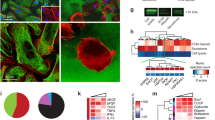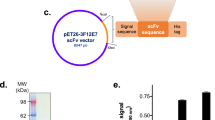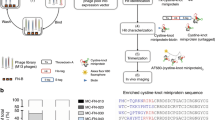Abstract
Experimental evidence suggests that blocking the interactions between endothelial cells and extracellular matrix (ECM) components may provide a potent and general strategy to inhibit tumor neovascularization. Based on these considerations, we have focused our efforts on laminin, component of the vascular basement membrane of every tumor-associated vessel, which serves an essential role in tube formation. We screened anti-laminin single-chain antibody fragments (scFv) derived from a human phage-display library and identified one that blocks the formation of capillary-like structures in vitro. This scFv inhibits angiogenesis in vivo in the chick embryo chorioallantoic membrane assay and prevents the establishment and growth of subcutaneous tumors in mice, either when administered as bolus protein therapy or when produced locally by gene-modified tumor cells. Our work represents the first demonstration of a direct in vivo therapeutic effect of a single-chain antibody secreted by gene-modified mammalian cells. These results open the way for a new antibody-based gene therapy strategy of cancer.
This is a preview of subscription content, access via your institution
Access options
Subscribe to this journal
Receive 12 print issues and online access
$259.00 per year
only $21.58 per issue
Buy this article
- Purchase on Springer Link
- Instant access to full article PDF
Prices may be subject to local taxes which are calculated during checkout




Similar content being viewed by others
References
Hanahan D, Folkman J . Patterns and emerging mechanisms of the angiogenic switch during tumorigenesis Cell 1996 86: 353–364
Boehm T, Folkman J, Browder T, O'Reilly MS . Antiangiogenic therapy of experimental cancer does not induce acquired drug resistance Nature 1997 390: 404–407
Carmeliet P, Jain RK . Angiogenesis in cancer and other diseases Nature 2000 407: 249–257
Achilles EG et al. Heterogeneity of angiogenic activity in a human liposarcoma: a proposed mechanism for ‘no take’ of human tumors in mice J Natl Cancer Inst 2001 93: 1075–1081
Maniotis AJ et al. Vascular channel formation by human melanoma cells in vivo and in vitro: vasculogenic mimicry Am J Pathol 1999 155: 739–752
Hendrix MJ et al. Expression and functional significance of VE-cadherin in aggressive human melanoma cells: role in vasculogenic mimicry Proc Natl Acad Sci USA 2001 98: 8018–8023
Kong HL, Crystal RG . Gene therapy strategies for tumor antiangiogenesis J Natl Cancer Inst 1998 90: 273–286
Seftor RE et al. Cooperative interactions of laminin 5 gamma2 chain, matrix metalloproteinase-2, and membrane type-1-matrix/metalloproteinase are required for mimicry of embryonic vasculogenesis by aggressive melanoma Cancer Res 2001 61: 6322–6327
Grant DS et al. Two different laminin domains mediate the differentiation of human endothelial cells into capillary-like structures in vitro Cell 1989 58: 933–943
Kubota Y, Kleinman HK, Martin GR, Lawley TJ . Role of laminin and basement membrane in the morphological differentiation of human endothelial cells into capillary-like structures J Cell Biol 1988 107: 1589–1598
Sanz L et al. Generation and characterization of recombinant human antibodies specific for native laminin epitopes. Potential application in cancer therapy Cancer Immunol Immunother 2001 50: 557–565
Viti F et al. Design and use of phage display libraries for the selection of antibodies and enzymes Meth Enzymol 2000 326: 480–505
Ades EW et al. HMEC-1: establishment of an immortalized human microvascular endothelial cell line J Invest Dermatol 1992 99: 683–690
Hawkins RE, Russell SJ, Winter G . Selection of phage antibodies by binding affinity. Mimicking affinity maturation J Mol Biol 1992 226: 889–896
Hawkins RE, Russell SJ, Winter G . Selection of phage antibodies by binding affinity. Mimicking affinity maturation Sanz L et al. Development of a computer-assisted high-throughput screening platform for anti-angiogenic screening. Microvasc Res (in press).
Raab U et al. Endoglin is expressed in the chicken vasculature and is involved in angiogenesis FEBS Lett 1999 459: 249–254
Osbourn JK et al. Generation of a panel of related human scFv antibodies with high affinities for human CEA Immunotechnology 1996 2: 181–196
Hudson PJ, Kortt AA . High avidity scFv multimers; diabodies and triabodies J Immunol Meth 1999 231: 177–189
Bateman A et al. Fusogenic membrane glycoproteins as a novel class of genes for the local and immune-mediated control of tumor growth Cancer Res 2000 60: 1492–1497
Nomura T et al. Gene expression and antitumor effects following direct interferon (IFN)-gamma gene transfer with naked plasmid DNA and DC-chol liposome complexes in mice Gene Therapy 1999 6: 121–129
Nilsson F, Kosmehl H, Zardi L, Neri D . Targeted delivery of tissue factor to the ED-B domain of fibronectin, a marker of angiogenesis, mediates the infarction of solid tumors in mice Cancer Res 2001 61: 711–716
Vitaliti A et al. Inhibition of tumor angiogenesis by a single-chain antibody directed against vascular endothelial growth factor Cancer Res 2000 60: 4311–4314
Álvarez-Vallina L . Genetic approaches for antigen selective gene therapy Curr Gene Ther 2001 1: 385–397
Chester J et al. Tumor antigen specific induction of transcriptionally targeted retroviral vectors for chimeric immune receptor-modified T cells Nature Biotech 2002 20: 256–263
Acknowledgements
This study was supported by the Fondo de Investigación Sanitaria (grants 99/0496 and 99/6047 to LA-V), the Helen C Levitt Endowed Visiting Professorship in Molecular Medicine at Mayo Foundation (to LA-V), the Danish Research Council (to PK) and the Carlsberg Foundation (to PK). LS was supported by the European Commission. BB is a recipient of a Comunidad Autónoma de Madrid training grant (01/0369/2000). We gratefully acknowledge JR Ramirez, C Corbacho and V Sánchez for immunohistochemical studies; E de la Rosa for chick CAM assays; M Santos and M Fuente for animal care; I Millán for statistical analysis; and MJ de Pablos for expert secretarial assistance.
Author information
Authors and Affiliations
Rights and permissions
About this article
Cite this article
Sanz, L., Kristensen, P., Blanco, B. et al. Single-chain antibody-based gene therapy: inhibition of tumor growth by in situ production of phage-derived human antibody fragments blocking functionally active sites of cell-associated matrices. Gene Ther 9, 1049–1053 (2002). https://doi.org/10.1038/sj.gt.3301725
Received:
Accepted:
Published:
Issue Date:
DOI: https://doi.org/10.1038/sj.gt.3301725
Keywords
This article is cited by
-
Bacterial secretion of soluble and functional trivalent scFv-based N-terminal trimerbodies
AMB Express (2015)
-
Oncolytic virotherapy
Nature Biotechnology (2012)
-
Factory neovessels: engineered human blood vessels secreting therapeutic proteins as a new drug delivery system
Gene Therapy (2010)
-
Inhibition of tumor growth in vivo by in situ secretion of bispecific anti-CEA × anti-CD3 diabodies from lentivirally transduced human lymphocytes
Cancer Gene Therapy (2007)
-
Replicating retroviral vectors mediating continuous production and secretion of therapeutic gene products from cancer cells
Cancer Gene Therapy (2005)



